
|
It brightened up to 5.6 mag in early December (Dec. 9, Marco Goiato). In mid December, it was visible at about 3 mag in the SOHO spacecraft images (Dec. 18, Hirohisa Sato). Now it is not observable. It will appear in the morning sky again in April. But then it will be fainter than 15 mag.
Date(TT) R.A. (2000) Decl. Delta r Elong. m1 Best Time(A, h)
Jan. 9 19 38.79 -12 37.4 1.738 0.791 10 9.2 21:01 ( 55,-22)
Jan. 16 20 11.53 -10 4.1 1.865 0.926 11 10.0 20:57 ( 59,-23)
|
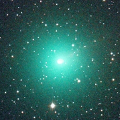
|
It brightened up to 7.3 mag in November (Nov. 7, Marco Goiato). Now it is fading. But it is bright as 11.7 mag still now (Jan. 9, Toshihiko Ikemura, Hirohisa Sato). In the Northern Hemisphere, it stays observable in excellent condition for a long time. In the Southern Hemisphere, it stays locating extremely low after this.
Date(TT) R.A. (2000) Decl. Delta r Elong. m1 Best Time(A, h)
Jan. 9 5 15.50 47 12.0 0.773 1.674 144 10.7 22:00 (180, 8)
Jan. 16 5 19.05 48 5.5 0.869 1.738 139 11.2 21:36 (180, 7)
|
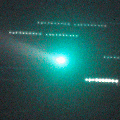
|
It brightened very rapidly in early December. Now it is very bright as 10.0 mag (Jan. 7, Michael Jager). In addition, Michael Jager observed two more components of 16.0-17.5 mag. It stays observable for a long time in this apparition.
Date(TT) R.A. (2000) Decl. Delta r Elong. m1 Best Time(A, h)
Jan. 9 23 41.30 -7 29.6 0.559 0.895 64 11.2 21:01 ( 97, 22)
Jan. 16 0 35.83 -6 27.2 0.536 0.947 70 11.5 20:57 (103, 28)
|

|
Five apparitions of this comet was confirmed in 1999, 2004, 2008, 2012 and 2016. It will approach to Sun down to 0.04 a.u. on Jan. 17. It may be observed on the ground in December and February.
Date(TT) R.A. (2000) Decl. Delta r Elong. m1 Best Time(A, h)
Jan. 9 17 28.00 -24 19.6 0.871 0.431 25 16.0 3:12 (298, 3)
Jan. 16 19 15.90 -22 52.3 0.979 0.143 8 11.5 3:21 (308,-10)
|

|
Now it is bright as 11.9 mag (Dec. 3, Ken-ichi Kadota). It stays 12 mag until March. In the Southern Hemisphere, it stays observable in good condition after this. In the Northern Hemisphere, it will never be observable after this.
Date(TT) R.A. (2000) Decl. Delta r Elong. m1 Best Time(A, h)
Jan. 9 14 39.64 -48 24.2 2.037 1.777 60 11.7 3:12 (307, 42)
Jan. 16 14 48.29 -54 3.9 1.988 1.805 64 11.7 3:21 (314, 47)
|
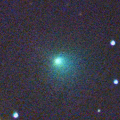
|
New periodic comet discovered in 2016. It had been predicted to return in 2024. But actually, it returned much earlier than predicted. Now it is bright as 12.3 mag (Jan. 11, Michael Jager). It passes the perihelion on Jan. 25. It will be unobservable soon also in the Northern Hemisphere. In the Southern Hemisphere, it will appear in the morning sky in early February, then it stays observable in excellent condition after that. In the Northern Hemisphere, it is hardly observable after the perihelion passage.
Date(TT) R.A. (2000) Decl. Delta r Elong. m1 Best Time(A, h)
Jan. 9 21 51.46 -6 8.6 0.747 0.628 39 13.3 21:01 ( 81, -2)
Jan. 16 22 2.67 -11 49.5 0.645 0.563 32 11.8 20:57 ( 75, -1)
|
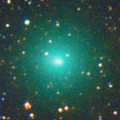
|
It brightened up to 8.2 mag in autumn (Oct. 13, Chris Wyatt). Now it is fading. But it is bright as 11.9 mag still now (Jan. 11, Chris Wyatt). It stays observable in the evening low sky while it will be getting fainter gradually, until early January in the Southern Hemisphere, or late February in the Northern Hemisphere.
Date(TT) R.A. (2000) Decl. Delta r Elong. m1 Best Time(A, h)
Jan. 9 22 36.12 -11 51.2 2.254 1.749 47 11.8 21:01 ( 83, 11)
Jan. 16 22 54.00 -9 54.4 2.343 1.792 45 12.1 20:57 ( 84, 8)
|
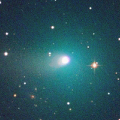
|
Brightened rapidly. It brightened up to 9.7 mag in November (Nov. 15, Chris Wyatt). Now it is fading. But it is bright as 12.0 mag still now (Jan. 11, Chris Wyatt). In the Northern Hemisphere, it stays observable in good condition for a long time. In the Southern Hemisphere, it locates extremely low after this.
Date(TT) R.A. (2000) Decl. Delta r Elong. m1 Best Time(A, h)
Jan. 9 1 32.87 29 43.3 0.880 1.462 103 11.8 21:01 (144, 14)
Jan. 16 1 52.74 32 11.2 0.950 1.496 101 12.3 20:57 (145, 12)
|

|
New bright comet. Now it is 11.9 mag (Jan. 8, Michael Mattiazzo). It brightens up to 11 mag in early February. In the Northern Hemisphere, it will be getting higher rapidly after this, and then it stays observable in excellent condition. In the Southern Heimsphere, now it is observable in excellent condition. But it will be getting lower rapidly after February, and it will be unobservable in mid March.
Date(TT) R.A. (2000) Decl. Delta r Elong. m1 Best Time(A, h)
Jan. 9 10 34.43 -49 13.2 0.926 1.427 96 12.4 3:12 (353, 75)
Jan. 16 9 53.57 -45 25.4 0.760 1.416 107 11.9 2:14 ( 0, 79)
|
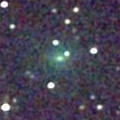
|
Brightened rapidly. Now it is very bright as 12.3 mag (Dec. 21, Ken-ichi Kadota). It will approach to Earth down to 0.46 a.u. in April, and it is expected to brighten up to 9 mag and to be observable in excellent condition. It becomes unobservable temporarily from January to February.
Date(TT) R.A. (2000) Decl. Delta r Elong. m1 Best Time(A, h)
Jan. 9 21 11.30 -18 6.8 2.147 1.337 26 12.4 21:01 ( 66, -3)
Jan. 16 21 7.07 -17 21.9 2.165 1.269 18 12.2 20:57 ( 62, -8)
|

|
First return of a new periodic comet which brightened up to 13 mag in 2009. Now it is bright as 11.7 mag (Jan. 10, Marco Goiato). It stays 12 mag until January, and it is observable in excellent condition.
Date(TT) R.A. (2000) Decl. Delta r Elong. m1 Best Time(A, h)
Jan. 9 4 56.80 4 42.9 0.395 1.315 141 12.4 21:41 (180, 50)
Jan. 16 5 8.49 9 1.2 0.416 1.326 139 12.5 21:25 (180, 46)
|
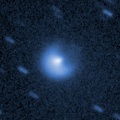
|
Now it is 14.2 mag (Jan. 12, Toshihiko Ikemura, Hirohisa Sato).
Date(TT) R.A. (2000) Decl. Delta r Elong. m1 Best Time(A, h)
Jan. 9 2 14.82 24 10.2 5.430 5.849 110 13.4 21:01 (149, 24)
Jan. 16 2 15.69 24 1.3 5.539 5.851 103 13.5 20:57 (144, 22)
|
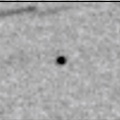
|
It will brighten up to 11.5 mag in spring. However, the condition is very bad in this apparition. It will appear in the morning low sky in March in the Southern Hemisphere, or in June in the Northern Hemisphere.
Date(TT) R.A. (2000) Decl. Delta r Elong. m1 Best Time(A, h)
Jan. 9 18 15.34 -19 9.0 2.535 1.610 15 13.9 3:12 (302,-10)
Jan. 16 18 37.73 -19 22.0 2.489 1.577 17 13.5 3:21 (300, -7)
|
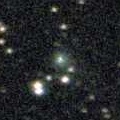
|
Now it is 13.0 mag (Jan. 9, Toshihiko Ikemura, Hirohisa Sato). It will brighten up to 11 mag in winter in 2022. In the Northern Hemisphere, it stays observable in good condition for a long time. In the Southern Hemisphere, it is not observable until 2021 November.
Date(TT) R.A. (2000) Decl. Delta r Elong. m1 Best Time(A, h)
Jan. 9 0 18.46 56 1.9 4.540 4.810 99 14.0 21:01 (150,-14)
Jan. 16 0 25.85 55 15.7 4.569 4.770 95 13.9 20:57 (148,-15)
|
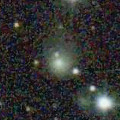
|
Now it is 14.3 mag (Jan. 10, Toshihiko Ikemura, Hirohisa Sato). It is expected to be observable at 5-6 mag for a long time from 2022 to 2023. In the Northern Hemisphere, it is not observable at the high light from 2022 summer to 2023 summer. In the Southern Hemisphere, it is not observable now. But it will be observable in good condition at the high light.
Date(TT) R.A. (2000) Decl. Delta r Elong. m1 Best Time(A, h)
Jan. 9 17 57.60 35 2.5 7.811 7.376 60 14.1 3:12 (249,-36)
Jan. 16 18 1.78 35 3.7 7.736 7.322 61 14.1 3:21 (246,-30)
|
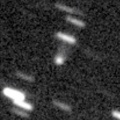
|
It will brighten up to 13 mag from spring to summer. In the Southern Hemisphere, it stays observable in good condition for a long time. In the Northern Hemisphere, it is not observable until July in 2022.
Date(TT) R.A. (2000) Decl. Delta r Elong. m1 Best Time(A, h)
Jan. 9 16 32.05 -48 6.7 4.561 3.892 42 14.2 3:12 (313, 24)
Jan. 16 16 43.42 -49 31.1 4.477 3.868 46 14.1 3:21 (313, 29)
|
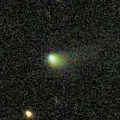
|
It stays 13-14 mag from 2020 to 2021. Appearing in the moring sky. It will be observable in good condition after this in the Southern Hemisphere. It locates somewhat low in the Northern Hemisphere.
Date(TT) R.A. (2000) Decl. Delta r Elong. m1 Best Time(A, h)
Jan. 9 17 0.23 -19 42.0 3.651 2.874 32 14.3 3:12 (291, 4)
Jan. 16 17 11.97 -20 15.5 3.593 2.871 37 14.2 3:21 (288, 10)
|
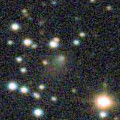
|
Now it is 15.6 mag (Jan. 4, Katsumi Yoshimoto). It will brighten up to 13.5 mag from winter to spring. In the Northern Hemisphere, it stays observable in excellent condition. In the Southern Hemisphere, it stays extremely low until spring.
Date(TT) R.A. (2000) Decl. Delta r Elong. m1 Best Time(A, h)
Jan. 9 0 30.33 31 40.1 1.246 1.607 91 14.5 21:01 (135, 5)
Jan. 16 0 48.66 30 7.3 1.238 1.552 87 14.4 20:57 (133, 5)
|

|
It had been observed as 8-9 mag for a long time in 2020. Now it is fading. Appearing in the moring sky. It will be observable in good condition after this in the Southern Hemisphere. It locates extremely low after this in the Northern Hemisphere.
Date(TT) R.A. (2000) Decl. Delta r Elong. m1 Best Time(A, h)
Jan. 9 17 0.39 -27 24.5 4.252 3.459 32 14.5 3:12 (297, 9)
Jan. 16 17 7.59 -28 21.7 4.253 3.526 37 14.6 3:21 (295, 15)
|
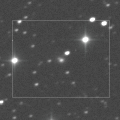
|
Now it is 14.9 mag (Oct. 10, Chris Wyatt). It will brighten up to 13.5 mag in spring. In the Southern Hemisphere, it stays observable in good condition for a long time, although it became unobservable temporarily in December. In the Northern Hemisphere, it is not observable until spring.
Date(TT) R.A. (2000) Decl. Delta r Elong. m1 Best Time(A, h)
Jan. 9 17 44.45 -42 0.0 4.317 3.482 28 15.1 3:12 (315, 10)
Jan. 16 17 46.96 -41 38.5 4.245 3.465 33 15.0 3:21 (311, 15)
|

|
Now it is 15.8 mag (Nov. 5, Ken-ichi Kadota). It will be unobservable soon.
Date(TT) R.A. (2000) Decl. Delta r Elong. m1 Best Time(A, h)
Jan. 9 21 27.90 -12 54.2 2.880 2.106 31 15.1 21:01 ( 73, -2)
Jan. 16 21 42.04 -11 6.2 2.911 2.098 28 15.1 20:57 ( 73, -5)
|

|
Now it is 14.8 mag (Dec. 12, Taras Prystavski). It stays 14-15 mag until the end of 2021. In the Southern Hemisphere, it stays observable in good condition for a long time. In the Northern Hemisphere, it is not observable until June.
Date(TT) R.A. (2000) Decl. Delta r Elong. m1 Best Time(A, h)
Jan. 9 20 56.72 -54 37.9 5.113 4.370 37 15.2 21:01 ( 35, 18)
Jan. 16 21 8.89 -53 19.6 5.124 4.362 35 15.2 20:57 ( 35, 16)
|
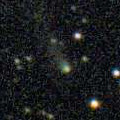
|
Now it is 15.9 mag (Nov. 10, Toshihiko Ikemura, Hirohisa Sato). It will stay at 14 mag for a long time from 2021 to 2022. In the Northern Hemisphere, it stays observable in good condition while brightening gradually, although it became unobservable temporarily in December. In the Southern Hemisphere, it is not observable until February.
Date(TT) R.A. (2000) Decl. Delta r Elong. m1 Best Time(A, h)
Jan. 9 18 4.55 4 31.4 6.291 5.487 32 15.4 3:12 (281,-23)
Jan. 16 18 7.79 4 7.1 6.235 5.466 35 15.3 3:21 (276,-16)
|
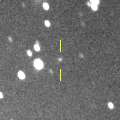
|
Now it is 15.4 mag (Dec. 3, Ken-ichi Kadota). It is expected to brighten up to 13 mag in 2022. It is observable in excellent condition in the Southern Hemisphere. In the Northern Hemisphere, it is observable from autumn to winter, but it locating extremely low.
Date(TT) R.A. (2000) Decl. Delta r Elong. m1 Best Time(A, h)
Jan. 9 8 23.37 -40 34.2 5.449 5.940 115 15.4 1:10 ( 0, 84)
Jan. 16 8 20.21 -40 40.0 5.378 5.903 117 15.4 0:39 ( 0, 84)
|
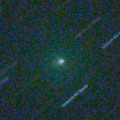
|
It brightened very rapidly up to 12.5 mag in early December (Dec. 7, Michael Jager). Now it is fading. It has already faded down to 16.3 mag (Jan. 8, Toshihiko Ikemura, Hirohisa Sato). It stays observable in excellent condition for a while.
Date(TT) R.A. (2000) Decl. Delta r Elong. m1 Best Time(A, h)
Jan. 9 2 38.30 6 7.7 0.804 1.470 110 15.4 21:01 (146, 43)
Jan. 16 2 57.09 6 10.5 0.868 1.496 107 15.8 20:57 (144, 42)
|

|
Now it is 14.5 mag (Dec. 21, Toshihiko Ikemura, Hirohisa Sato). In the Northern Hemisphere, it stays observable for a long time while it is getting fainter slowly. In the Southern Hemisphere, it will never be observable again.
Date(TT) R.A. (2000) Decl. Delta r Elong. m1 Best Time(A, h)
Jan. 9 16 28.35 60 28.7 4.927 5.019 89 15.6 3:12 (215,-30)
Jan. 16 16 32.38 60 58.9 4.950 5.066 91 15.6 3:21 (213,-27)
|

|
Now it is 16.3 mag (Nov. 9, Toshihiko Ikemura, Hirohisa Sato). It will brighten up to 14.5 mag from spring to summer. In the Southern Hemisphere, it stays observable in excellent condition for a long time. In the Northern Hemisphere, it is not observable after this.
Date(TT) R.A. (2000) Decl. Delta r Elong. m1 Best Time(A, h)
Jan. 9 21 37.92 -35 9.6 3.639 2.860 32 15.8 21:01 ( 56, 12)
Jan. 16 21 44.27 -35 47.2 3.655 2.833 28 15.8 20:57 ( 53, 10)
|

|
Now it is 17.4 mag (Sept. 16, Blue Mountains Observatory, Leura). It will brighten up to 15.5 mag in early 2021. It stays unobservable until June.
Date(TT) R.A. (2000) Decl. Delta r Elong. m1 Best Time(A, h)
Jan. 9 19 46.98 -28 22.2 2.708 1.742 8 16.0 21:01 ( 45,-10)
Jan. 16 20 8.80 -26 55.3 2.680 1.709 7 15.9 20:57 ( 46,-11)
|

|
First return of a new periodic comet which brightened up to 14-15 mag in 2006. Now it is 16.0 mag (Jan. 10, Toshihiko Ikemura, Hirohisa Sato). It will brighten up to 15-16 mag from February to March, and will be observable in good condition.
Date(TT) R.A. (2000) Decl. Delta r Elong. m1 Best Time(A, h)
Jan. 9 12 2.53 1 54.2 1.184 1.767 108 16.1 3:12 (217, 47)
Jan. 16 12 16.00 2 28.5 1.123 1.759 113 16.0 3:21 (209, 49)
|
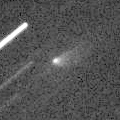
|
First return of a new periodic comet which brightened up to 17 mag in 2013. Now it is 15.7 mag (Dec. 26, Thomas Lehmann). It stays 16 mag until January.
Date(TT) R.A. (2000) Decl. Delta r Elong. m1 Best Time(A, h)
Jan. 9 13 12.48 11 4.9 0.485 1.142 96 16.0 3:12 (228, 29)
Jan. 16 13 26.88 7 30.3 0.493 1.162 98 16.1 3:21 (226, 35)
|

|
It brightened rapidly and became brighter than expected. Now it is 15.7 mag (Jan. 11, Sandor Szabo). It is observable in good condition in the Northern Hemisphere. It locates somewhat low in the Southern Hemisphere.
Date(TT) R.A. (2000) Decl. Delta r Elong. m1 Best Time(A, h)
Jan. 9 2 44.73 26 29.4 1.239 1.906 117 16.1 21:01 (157, 25)
Jan. 16 2 54.91 25 22.1 1.302 1.910 112 16.1 20:57 (154, 25)
|
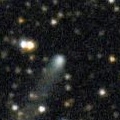
|
Now it is 15.6 mag (Nov. 10, Toshihiko Ikemura, Hirohisa Sato). It stays 15-16 mag for a long time until 2021. In the Northern Hemisphere, it stays observable in good condition for a long time, although it becomes very low temporarily from December to January. In the Southern Hemisphere, it will be observable in the extremely low sky only in next spring.
Date(TT) R.A. (2000) Decl. Delta r Elong. m1 Best Time(A, h)
Jan. 9 18 56.12 23 1.4 5.412 4.775 45 16.2 3:12 (270,-43)
Jan. 16 18 59.86 23 57.4 5.417 4.795 46 16.3 3:21 (265,-37)
|
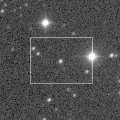
|
Now it is 16.1 mag (Jan. 9, Toshihiko Ikemura, Hirohisa Sato). It is bright as 14.7 mag visually (Jan. 11, Sandor Szabo). It will be fading after this, and will be fainter than 18 mag in April. In the Northern Hemisphere, it stays observable in good condition for a long time after this. In the Southern Hemisphere, it will be unobservable in January.
Date(TT) R.A. (2000) Decl. Delta r Elong. m1 Best Time(A, h)
Jan. 9 0 0.16 13 36.6 1.156 1.341 77 16.4 21:01 (117, 12)
Jan. 16 0 18.00 17 57.0 1.212 1.365 76 16.5 20:57 (119, 8)
|
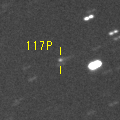
|
Now it is 16.8 mag (Jan. 10, Toshihiko Ikemura, Hirohisa Sato). It will brighten up to 13 mag in 2022. In 2021, it is observable at 15-16 mag in good condition.
Date(TT) R.A. (2000) Decl. Delta r Elong. m1 Best Time(A, h)
Jan. 9 13 33.21 -2 18.7 3.831 3.892 86 16.5 3:12 (244, 36)
Jan. 16 13 36.99 -2 34.0 3.709 3.877 92 16.4 3:21 (237, 42)
|

|
It approached to Sun down to 0.14 a.u. on Dec. 7, and it must have brightened up to 11 mag. But it was not observable at the high light. In the Northern Hemisphere, it is observable in the evening low sky from January to February. It is not observable in the Southern Hemisphere.
Date(TT) R.A. (2000) Decl. Delta r Elong. m1 Best Time(A, h)
Jan. 9 21 32.60 -0 25.9 1.409 0.889 38 16.5 21:01 ( 84, -9)
Jan. 16 22 4.86 2 53.7 1.531 1.011 40 16.8 20:57 ( 88, -9)
|
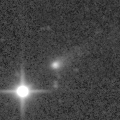
|
Now it is 15.9 mag (Jan. 8, Toshihiko Ikemura, Hirohisa Sato). It is expected to brighten up to 14 mag from spring to summer, and it stays observable in good condition for a long time.
Date(TT) R.A. (2000) Decl. Delta r Elong. m1 Best Time(A, h)
Jan. 9 13 20.32 25 49.5 2.619 2.946 99 16.8 3:12 (220, 17)
Jan. 16 13 28.65 26 14.7 2.493 2.892 103 16.6 3:21 (215, 20)
|
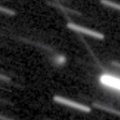
|
Now it is 16.4 mag (Dec. 17, Toshihiko Ikemura, Hirohisa Sato). It is observable at 16.5-17 mag from 2020 to 2021. In the Southern Hemisphere, it is not observable until summer.
Date(TT) R.A. (2000) Decl. Delta r Elong. m1 Best Time(A, h)
Jan. 9 22 17.42 48 28.6 6.034 5.958 80 16.6 21:01 (133,-25)
Jan. 16 22 21.25 47 22.1 6.112 5.955 76 16.6 20:57 (130,-28)
|

|
Now it is 16.6 mag (Nov. 9, Toshihiko Ikemura, Hirohisa Sato). It stays at 16-17 mag from 2020 to 2021. In the Northern Hemisphere, it stays observable in good condition for a long time. It is not observable in the Southern Hemisphere.
Date(TT) R.A. (2000) Decl. Delta r Elong. m1 Best Time(A, h)
Jan. 9 19 20.11 30 32.9 9.387 8.826 52 16.8 3:12 (263,-51)
Jan. 16 19 23.16 30 58.9 9.390 8.824 52 16.8 3:21 (259,-44)
|

|
It brightened up to 13.8 mag in autumn in 2019 (Sept. 3, 2019, Chris Wyatt). Now it is fading slowly. It has already faded down to 17.2 mag (Jan. 8, Toshihiko Ikemura, Hirohisa Sato).
Date(TT) R.A. (2000) Decl. Delta r Elong. m1 Best Time(A, h)
Jan. 9 23 46.59 4 52.0 7.229 6.960 70 16.9 21:01 (107, 15)
Jan. 16 23 48.57 5 19.3 7.380 7.002 63 17.0 20:57 (104, 10)
|

|
Tiny comet of Kreutz group. It was visible at 5 mag on the ground at the total eclipse on Dec. 14. It is observable in the Southern Hemisphere. But it must have already disappeared.
Date(TT) R.A. (2000) Decl. Delta r Elong. m1 Best Time(A, h)
Jan. 9 2 53.89 -88 3.3 0.556 0.937 68 16.9 21:01 ( 1, 38)
Jan. 16 4 33.37 -67 59.1 0.617 1.105 84 17.9 20:57 ( 2, 58)
|
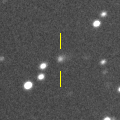
|
It brightened up to 16.1 mag in last winter (Mar. 18, Toshihiko Ikemura, Hirohisa Sato). Now it is 17.8 mag (Jan. 8, Toshihiko Ikemura, Hirohisa Sato). In 2021, it stays observable at 17 mag in good condition until summer.
Date(TT) R.A. (2000) Decl. Delta r Elong. m1 Best Time(A, h)
Jan. 9 13 9.44 -20 22.1 6.801 6.786 84 17.0 3:12 (259, 51)
Jan. 16 13 11.42 -20 26.9 6.701 6.797 91 17.0 3:21 (252, 58)
|
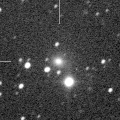
|
It brightened up to 13.5 mag in last winter (Dec. 6, 2019, Chris Wyatt). Now it is fading slowly. Now it is 17.9 mag (Jan. 8, Toshihiko Ikemura, Hirohisa Sato). In the Southern Hemisphere, it stays observable for a long time. It locates somewhat low in the Northern Hemisphere. Taras Prystavski found its fragmentation on Sept. 12.
Date(TT) R.A. (2000) Decl. Delta r Elong. m1 Best Time(A, h)
Jan. 9 1 12.98 -22 56.6 5.051 4.973 79 17.0 21:01 ( 94, 48)
Jan. 16 1 13.25 -21 30.6 5.195 5.015 74 17.1 20:57 ( 92, 43)
|
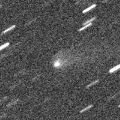
|
Now it is 16.9 mag (Jan. 8, Toshihiko Ikemura, Hirohisa Sato). It stays observable in good condition. But it will be fading after this, and will be fainter than 18 mag in February. It locates somewhat low in the Southern Hemisphere.
Date(TT) R.A. (2000) Decl. Delta r Elong. m1 Best Time(A, h)
Jan. 9 8 22.95 21 25.3 1.591 2.555 165 17.1 1:10 (180, 34)
Jan. 16 8 16.05 22 9.4 1.613 2.594 174 17.3 0:36 (180, 33)
|

|
It stays observable at 16-17 mag from 2021 to 2022.
Date(TT) R.A. (2000) Decl. Delta r Elong. m1 Best Time(A, h)
Jan. 9 14 19.34 -27 27.3 5.441 5.146 67 17.3 3:12 (279, 40)
Jan. 16 14 22.59 -27 10.9 5.310 5.125 73 17.2 3:21 (274, 47)
|

|
Now it is 17.0 mag (Jan. 10, Toshihiko Ikemura, Hirohisa Sato). It is expected to brighten up to 13 mag in 2022. In the Southern Hemisphere, it stays observable in good condition for a long time. In the Northern Hemisphere, it stays observable until June when it brightens up to 16 mag. But it will not be observable at the high light.
Date(TT) R.A. (2000) Decl. Delta r Elong. m1 Best Time(A, h)
Jan. 9 14 11.07 -15 2.6 5.899 5.690 72 17.5 3:12 (263, 36)
Jan. 16 14 11.34 -15 39.3 5.732 5.642 79 17.3 3:21 (258, 44)
|

|
Now it is 17.9 mag (Nov. 19, Giuseppe Pappa). It is expected to brighten up to 12 mag in 2022. In the Southern Hemisphere, it stays observable in good condition for a long time. In the Northern Hemisphere, it locates extremely low until mid February, then it becomes unobservable until 2022.
Date(TT) R.A. (2000) Decl. Delta r Elong. m1 Best Time(A, h)
Jan. 9 2 57.33 -49 24.9 6.285 6.322 87 17.5 21:01 ( 40, 69)
Jan. 16 2 52.66 -48 53.9 6.301 6.273 83 17.5 20:57 ( 47, 66)
|

|
Now it is 17.7 mag (Sept. 14, Slooh.com Chile Observatory, La Dehesa). It will brighten up to 16.5 mag in summer.
Date(TT) R.A. (2000) Decl. Delta r Elong. m1 Best Time(A, h)
Jan. 9 16 55.03 -37 56.2 5.960 5.185 34 17.5 3:12 (306, 16)
Jan. 16 17 1.35 -37 34.2 5.879 5.166 40 17.5 3:21 (302, 21)
|
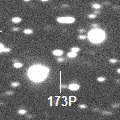
|
Now it is 17.0 mag (Jan. 10, Toshihiko Ikemura, Hirohisa Sato). It is observable at 17-18 mag for a long time from late 2019 to early 2021. It will fade out before it passes the perihelion.
Date(TT) R.A. (2000) Decl. Delta r Elong. m1 Best Time(A, h)
Jan. 9 5 28.06 18 40.5 3.554 4.455 153 17.5 22:11 (180, 36)
Jan. 16 5 24.78 18 58.4 3.599 4.446 145 17.6 21:41 (180, 36)
|
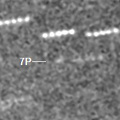
|
Now it is 19.1 mag (Jan. 8, Toshihiko Ikemura, Hirohisa Sato). It will brighten up to 11 mag from May to August. In the Southern Hemisphere, it stays observable in excellent condition for a long time. In the Northern Hemisphere, it stays observable in good condition for a while. But it becomes extremely low after July.
Date(TT) R.A. (2000) Decl. Delta r Elong. m1 Best Time(A, h)
Jan. 9 14 19.00 11 1.9 1.894 1.993 81 17.8 3:12 (242, 18)
Jan. 16 14 34.55 10 39.8 1.780 1.939 83 17.5 3:21 (238, 22)
|
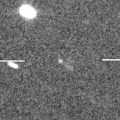
|
Now it is 18.7 mag (Dec. 26, Thomas Lehmann). It is expected to brighten up to 10 mag in 2023. In the Northern Hemisphere, it stays observable in good condition until 2023 autumn. In the Southern Hemipshere, it stays extremely low until mid July, then it becomes unobservable for a while. But it becomes observable in good condition after 2023 summer.
Date(TT) R.A. (2000) Decl. Delta r Elong. m1 Best Time(A, h)
Jan. 9 13 20.32 27 35.1 7.990 8.220 100 17.7 3:12 (219, 15)
Jan. 16 13 20.13 28 18.5 7.839 8.169 106 17.6 3:21 (212, 19)
|

|
Now it is 17.7 mag (Nov. 3, ATLAS-HKO, Haleakala). Although it is an asteroid, it is brightening rapidly. It may brighten up to 11 mag in 2023. In the Northern Hemisphere, it stays observable in good condition for a long time. In the Southern Hemisphere, it is not observable now. It will appear in mid March, but it stays extremely low after that.
Date(TT) R.A. (2000) Decl. Delta r Elong. m1 Best Time(A, h)
Jan. 9 18 21.24 36 51.8 8.028 7.595 60 17.7 3:12 (249,-41)
Jan. 16 18 23.96 37 4.4 7.969 7.550 61 17.7 3:21 (246,-35)
|

|
First return of a new periodic comet which brightened up to 17.5 mag in 2012. Now it is 18.7 mag (Jan. 9, Toshihiko Ikemura, Hirohisa Sato). It will be fading after this.
Date(TT) R.A. (2000) Decl. Delta r Elong. m1 Best Time(A, h)
Jan. 9 4 26.45 37 19.2 1.858 2.684 139 17.8 21:10 (180, 18)
Jan. 16 4 25.48 36 51.0 1.941 2.708 132 17.9 20:57 (177, 18)
|

|
Now it is 18.7 mag (Jan. 10, Toshihiko Ikemura, Hirohisa Sato). It stays 17-18 mag for a long time from 2021 to 2023.
Date(TT) R.A. (2000) Decl. Delta r Elong. m1 Best Time(A, h)
Jan. 9 11 12.82 9 17.7 4.400 5.005 123 17.9 3:12 (197, 44)
Jan. 16 11 12.17 9 24.7 4.303 4.996 130 17.8 3:21 (184, 46)
|
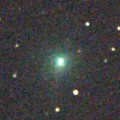
|
It approached to Sun down to 0.34 a.u. on Oct. 20. Then the nucleus was disintegrated. After the perihelion passage, it was observed at 12.5 mag (Oct. 28, Michael Jager). It must have already disappeared.
Date(TT) R.A. (2000) Decl. Delta r Elong. m1 Best Time(A, h)
Jan. 9 15 43.05 5 48.6 2.049 1.778 60 18.1 3:12 (259, 5)
Jan. 16 15 47.69 5 59.9 2.074 1.891 65 18.4 3:21 (254, 12)
|

|
It approached to Sun down to 0.29 a.u. on July 3, and it brightened up to 0.6 mag (Alan Hale). It had been fainter than 15.0 mag in October (Oct. 12, Mitsunori Tsumura). Appearing in the morning sky. But it must be already extremely faint.
Date(TT) R.A. (2000) Decl. Delta r Elong. m1 Best Time(A, h)
Jan. 9 16 31.44 -23 44.6 4.062 3.354 38 19.9 3:12 (291, 12)
Jan. 16 16 34.73 -24 12.5 4.064 3.442 45 20.1 3:21 (287, 19)
|
|
![]()
 C/2019 N1 ( ATLAS )
C/2019 N1 ( ATLAS ) P/2021 A3 ( STEREO )
P/2021 A3 ( STEREO ) 88P/Howell
88P/Howell 156P/Russell-LINEAR
156P/Russell-LINEAR C/2021 A2 ( NEOWISE )
C/2021 A2 ( NEOWISE ) C/2020 R4 ( ATLAS )
C/2020 R4 ( ATLAS ) 398P/2020 P2 ( Boattini )
398P/2020 P2 ( Boattini ) 29P/Schwassmann-Wachmann 1
29P/Schwassmann-Wachmann 1 10P/Tempel 2
10P/Tempel 2 C/2019 L3 ( ATLAS )
C/2019 L3 ( ATLAS ) C/2017 K2 ( PanSTARRS )
C/2017 K2 ( PanSTARRS ) C/2019 F1 ( ATLAS-Africano )
C/2019 F1 ( ATLAS-Africano ) 246P/NEAT
246P/NEAT C/2020 N1 ( PanSTARRS )
C/2020 N1 ( PanSTARRS ) C/2017 T2 ( PanSTARRS )
C/2017 T2 ( PanSTARRS ) C/2020 J1 ( SONEAR )
C/2020 J1 ( SONEAR ) 17P/Holmes
17P/Holmes C/2020 F5 ( MASTER )
C/2020 F5 ( MASTER ) C/2018 U1 ( Lemmon )
C/2018 U1 ( Lemmon ) C/2019 T4 ( ATLAS )
C/2019 T4 ( ATLAS ) 11P/Tempel-Swift-LINEAR
11P/Tempel-Swift-LINEAR C/2018 N2 ( ASASSN )
C/2018 N2 ( ASASSN ) C/2019 T2 ( Lemmon )
C/2019 T2 ( Lemmon ) 28P/Neujmin 1
28P/Neujmin 1 409P/2020 V1 ( LONEOS-Hill )
409P/2020 V1 ( LONEOS-Hill ) 405P/2020 U1 ( Lemmon )
405P/2020 U1 ( Lemmon ) 277P/LINEAR
277P/LINEAR C/2019 K7 ( Smith )
C/2019 K7 ( Smith ) 162P/Siding Spring
162P/Siding Spring 117P/Helin-Roman-Alu 1
117P/Helin-Roman-Alu 1 (3200) Phaethon
(3200) Phaethon C/2020 T2 ( Palomar )
C/2020 T2 ( Palomar ) C/2019 T3 ( ATLAS )
C/2019 T3 ( ATLAS ) C/2019 O3 ( Palomar )
C/2019 O3 ( Palomar ) C/2017 B3 ( LINEAR )
C/2017 B3 ( LINEAR ) C/2020 X3 ( SOHO )
C/2020 X3 ( SOHO ) C/2019 C1 ( ATLAS )
C/2019 C1 ( ATLAS ) C/2018 F4 ( PanSTARRS )
C/2018 F4 ( PanSTARRS ) 84P/Giclas
84P/Giclas C/2020 H6 ( ATLAS )
C/2020 H6 ( ATLAS ) C/2020 Y2 ( ATLAS )
C/2020 Y2 ( ATLAS ) C/2020 R7 ( ATLAS )
C/2020 R7 ( ATLAS ) C/2020 O2 ( Amaral )
C/2020 O2 ( Amaral ) 173P/Mueller 5
173P/Mueller 5 7P/Pons-Winnecke
7P/Pons-Winnecke C/2020 V2 ( ZTF )
C/2020 V2 ( ZTF ) A/2019 U5
A/2019 U5 397P/2020 M2 ( Lemmon )
397P/2020 M2 ( Lemmon ) 99P/Kowal 1
99P/Kowal 1 C/2020 P1 ( NEOWISE )
C/2020 P1 ( NEOWISE ) C/2020 F3 ( NEOWISE )
C/2020 F3 ( NEOWISE )![]()















































